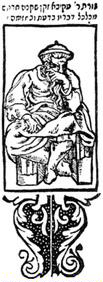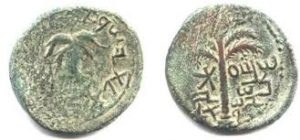 No. At least not in the time of Bar Kochba‘s revolt against Rome, 132-136 ce.
No. At least not in the time of Bar Kochba‘s revolt against Rome, 132-136 ce.
That’s if we can trust the later rabbinic evidence that attributed certain beliefs to famous Rabbi Akiba who supported Bar Kochba’s claim to be the messiah.
(The relevance of this discussion to Christian origins lies in the context of arguments that Jesus being said, at various places, to have been of the seed of David or of Davidic descent. For starters, given modern scholarly (archaeological) understanding of the reality of “King David”, and even the “Davidic dynasty”, there was evidently no such thing as a “family of David” existing in Palestine at the time of Jesus, before and later, anyway.)
Bar Kochba’s original name was Simeon ben Kosiba. It was subsequently changed to Bar Kochba, which was Aramaic for “Son of a Star”, an allusion to the prophecy of Numbers 24:17. (This sort of name change based on a pun on the original name in order to fit a biblical prophecy is worth keeping in mind when one compares other apparent puns in names found within the gospels.)
The rabbinic passage is discussing this bible’s reference to the plural “thrones” in heaven, one for the Ancient of Days, and another, presumably, for the Son of Man (Daniel 7:9, 13-14). The passage follows on from references to a biblical contradiction where God is described as an old man (with white hair) in Daniel 7, but as a young black-headed man according to their interpretation of Song of Solomon 5:11.
One passage says: His throne was fiery flames; and another Passage says: Till thrones were placed, and One that was ancient of days did sit!
— There is no contradiction: one [throne] for Him, and one for David; this is the view of R. Akiba.
Said R. Jose the Galilean to him: Akiba, how long wilt thou treat the Divine Presence as profane! Rather, [it must mean], one for justice and one for grace.
Did he accept [this explanation from him, or did he not accept it?
— Come and hear: One for justice and one for grace; this is the view of R. Akiba. (Hagigah, 14a)
This passage in the Hagigah is really a little debate about whether the two thrones in Daniel 7 are for two separate divine beings, or if they really represent two aspects of the one divine being, God. In this “correct” view that Akiba is said to have at first opposed, but eventually agreed with, the Son of Man represents God as the youthful warrior executing justice, while the Ancient of Days represents God as the indulgent old man dispensing grace. (Another disputant later chimes in by arguing one of the thrones was really only the footstool for the other!)
It seems scarcely likely that Akiba did actually change his mind, since he was killed before the war’s end. So we are thrown up doubts about the reliability of the passage as a whole. If it appeared in the gospels, many critics would argue that the whole debate is written to meet the needs of its day, and the different arguments are put in the mouths of renowned past masters for rhetorical effect.
But for the sake of argument, and holding in abeyance for now all the caveats, let’s accept at least the first part of the passage as reflecting the belief and teaching of Rabbi Akiba in the time of the Bar Kochba revolt.
What Akiba taught was that in Daniel 7 there were two thrones in heaven. One for the Ancient of Days and the other for David.
That can only mean (I think) that Akiba was said to have believed that the throne of the Son of Man in heaven was the throne of the Davidic Messiah.
Akiba in the 130s ce, we might say, taught that the Book of Daniel’s Son of Man was the Davidic Messiah in heaven.
But we also know (or are informed) that Akiba supported the messianic claim of Bar Kochba, who is nowhere said to have been of the line of David. (I don’t think there was any such thing as a real Davidic lineage except in literature, as mentioned earlier, anyway.)
Nonetheless, according to the rabbinic tradition, Akiba at the same time taught that the Messiah in heaven is “David”, apparently metonymy for the Messianic throne.
Much of the above is derived from Alan F. Segal’s Two Powers in Heaven.
The beliefs are not at all necessarily contradictory. We know enough about ancient beliefs to understand that the earthly is often said to represent the events and conditions above. So it would appear that Jews in the time of the Bar Kochba rebellion could conceive of an earthly Messiah who was, according to a strictly heavenly designation, also a Davidic Messiah. The earthly Messiah’s genealogy had nothing to do with it.
Much of the following is derived from Margaret Barker’s The Great Angel.
There is nothing to suggest that R. Akiba saw the Davidic messiah figure, for whom the second throne was set, as merely human; he could have viewed the Messiah as a manifestation of the second divine figure. He saw in Bar Kochba a political messiah, but this does not exclude the possibility that that Messiah figure was thought to have had a heavenly aspect. (pp.155-6)
Another point of significance that Barker brings out is how early such discussions and beliefs must have been. If we accept the Hagigah 14a passage as evidence for the historical Akiba’s beliefs in the early 130s, then we might fairly conclude that he is addressing or countering debates and controversies that existed prior to his time.
In other words, we have some reason to think that, according to this Jewish evidence, the idea of the Son of Man in Daniel 7 should be interpreted as the Messiah precedes the 130s. Presumably this is evidence for other Jewish sects, possibly the Christians too, having such beliefs or debates at the turn of the century.
Of additional interest is Margaret Barker’s conclusion of this particular discussion by reference to Justin’s Dialogue with Trypho. This testifies to being written soon after the Bar Kochba war.
In this work, Justin is engaging a Jew in a debate (Justin is the author of both sides, of course). What is significant here is that Justin merely finds himself debating the identity of the Son of Man — whether it was Jesus or someone else. There is no controversy over whether or not the Son of Man was a Messianic figure. It appears that Justin can presume that even the Jews he knew, whom he summed up in Trypho, took for granted that Daniel 7’s Son of Man was understood to be the Messiah.
And when I had ceased, Trypho said, “These and such like Scriptures, sir, compel us to wait for Him who, as Son of man, receives from the Ancient of days the everlasting kingdom. But this so-called Christ of yours was dishonourable and inglorious, so much so that the last curse contained in the law of God fell on him, for he was crucified.” (Trypho, 32)
If you enjoyed this post, please consider donating to Vridar. Thanks!


Off topic I know, only tangentally connected, but I am beginning to wonder if David and several other individuals were not gods and demigods in ancient Israelite religion. When monotheism rose, rather than erasing the more favored gods, they could have hisoricised them. This is said to have been done with Celtic mythology after Christianity made its way to Celtic regions. Rather than lose all that Pagan culture, just change the favored gods to kings and generals of the past, and completely erase only the unfavored gods, thus making all that cultural heritage and all those stories compatible with monotheism.
Goldziher and Martineau in “Mythology among the Hebrews and its historical development” (1877) observed the following sun god links with David:
Frank Moore Cross in “Canaanite Myth and Hebrew Epic” (1973) notes the following in common with mythic Canaanite tales:
I think I have seen somewhere the image of the lyre player and shepherd being drawn from Baal or another god, but cannot recall where or the details now.
Thus saith the Creator YHAH TSABA EL SHADDY!
Indeed the Davidic Messiah or The BRANCH for Such A Time As This.
The Branch shall continue to rule as Prophet, Priest and King.
I will make Jerusalem and Judah like a cup of poison to all nations that send their armies to surround her with synthetic hope!
Jerusalem has been and is A Stone of molten fire that will consumed the world.
YHAH will defend the people Jerusalem; the weakest amongst us will be as King David!
And the royal line or the Branch will as YAH, like the Angel of EL SHADDY who encounter Pharaoh.
Then I will pour out the spirit of grace and acclaim and Israel, Judah and the nations will look on him they pierced, and morn for him as for an only son. Zechariah 12.
This day these words are fulfill in your hearing.
All human beings have one thing in common. When the world around them is crumbling they need some form of hope for better times to come. The Jews did this by creating the Messiah Idea. The Christians followed by amending the requirements. Later Islam incorporated their own version. Followed by the
Ba Hai . Unfortunately I doubt if one human being no matter how perfect he might be could bring peace and justice to this world. If I asked everyone contributing to this blog to start following the golden rule who would listen?
Ive read in a book that King David and King Solomon can be found as the pharoahs Thutmoses Iv and Amenhotep III. Anyway the author said that the Egyptian “David” had a nick name that included star, and one cannot forget the star of David.
http://en.wikipedia.org/wiki/Pharaoh%27s_daughter_(wife_of_Solomon)#Parallels_with_Amenhotep_III_and_Sitamun
So again why am i talking about stars, because by calling himself son of a star he is in effect a son of David another star.